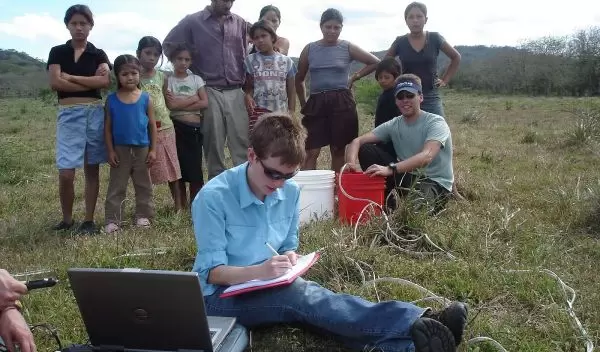
The Search for Drinking Water in Nicaragua
Boaco, like many communities around the world, has serious water supply and quality problems. My thesis research brought me to the small, rural town in Nicaragua, where I have been working with my advisor, John Geirke, to identify geological lineaments (fractures) from satellite imagery that will improve groundwater exploration and siting of wells in this rugged terrain.
Working towards my master's thesis in geological engineering from Michigan Technological University, I experienced the water scarcity first hand at our motel in downtown Boaco. The motel water supply was intermittent, only on for what seemed like a few hours every other day. A holding tank in the motel courtyard would fill up and provide water for the business and guests during the long intervals of time when the water was off.
To conserve the small water stash, the two motel showers were pilas, troughs from which you dip in bowls to collect water to dump over your body.
Similarly, a visit to the bathroom first required a visit to the holding tank for a bucket of water for flushing.
Of course, this water isn't drinkable--it is contaminated due to its source, mostly from a polluted river, and from cross-contamination of the distribution piping system with the wastewater lines.
One objective of my fieldwork was to see what geologic lineaments, identified from satellite imagery, actually look like from a ground perspective. So I sought out the lineaments by rental truck, with maps in hand.
Often, "roads" on the map turned out to be what I would consider cow paths. Bridges were lacking, giving us no choice but to simply drive through rivers. An unexpected benefit from this method of travel was an inside view of the Nicaraguan countryside. Besides lineaments, I saw a wide variety of wildlife including sloths, monkeys, many exotic birds and a few ominous-looking snakes.
A particularly challenging facet of this research was performing well-pumping tests on drilled, hand-pump wells to check the validity of my lineament interpretations. Significant time and effort was necessary to acquire community cooperation, since every well we tested had to remain unused for several hours prior to the test.
Finding the "keepers" of a well often sent us on a wild goose chase where we talked with just about everyone in the community. Getting a well-keeper to agree to let me test the well often meant performing tests before 6 o'clock in the morning in order to minimize disturbance to the community.
Once the pumping test began, we would try to gather people to fill their buckets with the water that was being extracted, instead of wastefully dumping it on the ground.
It was the same for every well. At first, just a few curious kids with their buckets would show up and carry the water back to their homes. Quickly they would return, only this time with their families, friends and neighbors--and everyone brought buckets. By the time pumping stopped, it seemed like the entire community would be present, always interested in the test, the results, and, of course, the gringos.
I feel very fortunate to have had the opportunity to perform fieldwork in Nicaragua. Carrying out a successful scientific investigation under less than ideal circumstances required me to be both creative and flexible when solving problems.
Rolling with the punches was the only option at times. It was a hard, yet important, truth for my engineering mind to come to terms with. Also, experiencing and learning from the Nicaraguan people, their culture and way of life was invaluable. This has given me a new, wider perspective on many issues our world is facing today and has produced in me a gratitude for the relative ease of my own daily life.
-- Jill Bruning, Michigan Technological University jill.bruning@gmail.com
This Behind the Scenes article was provided to LiveScience in partnership with the National Science Foundation.


